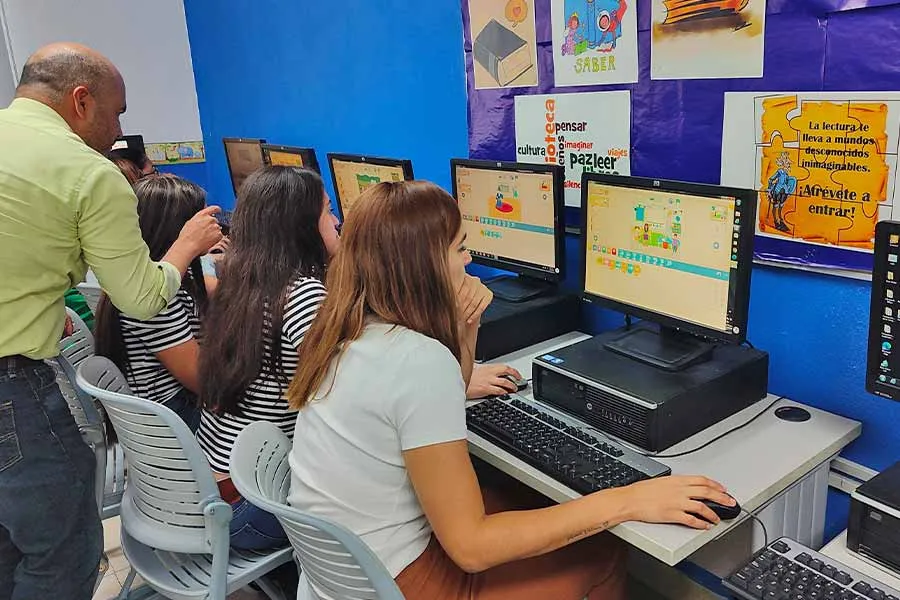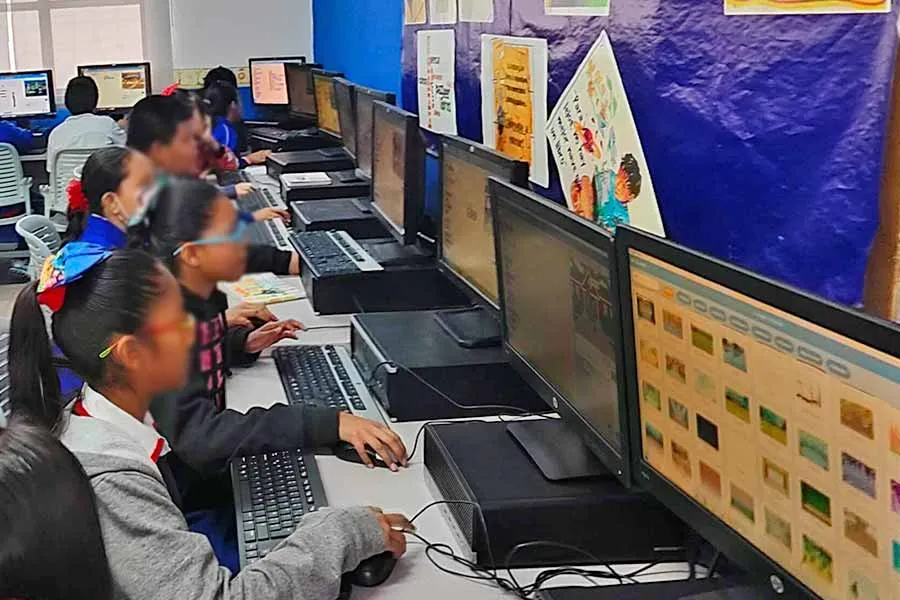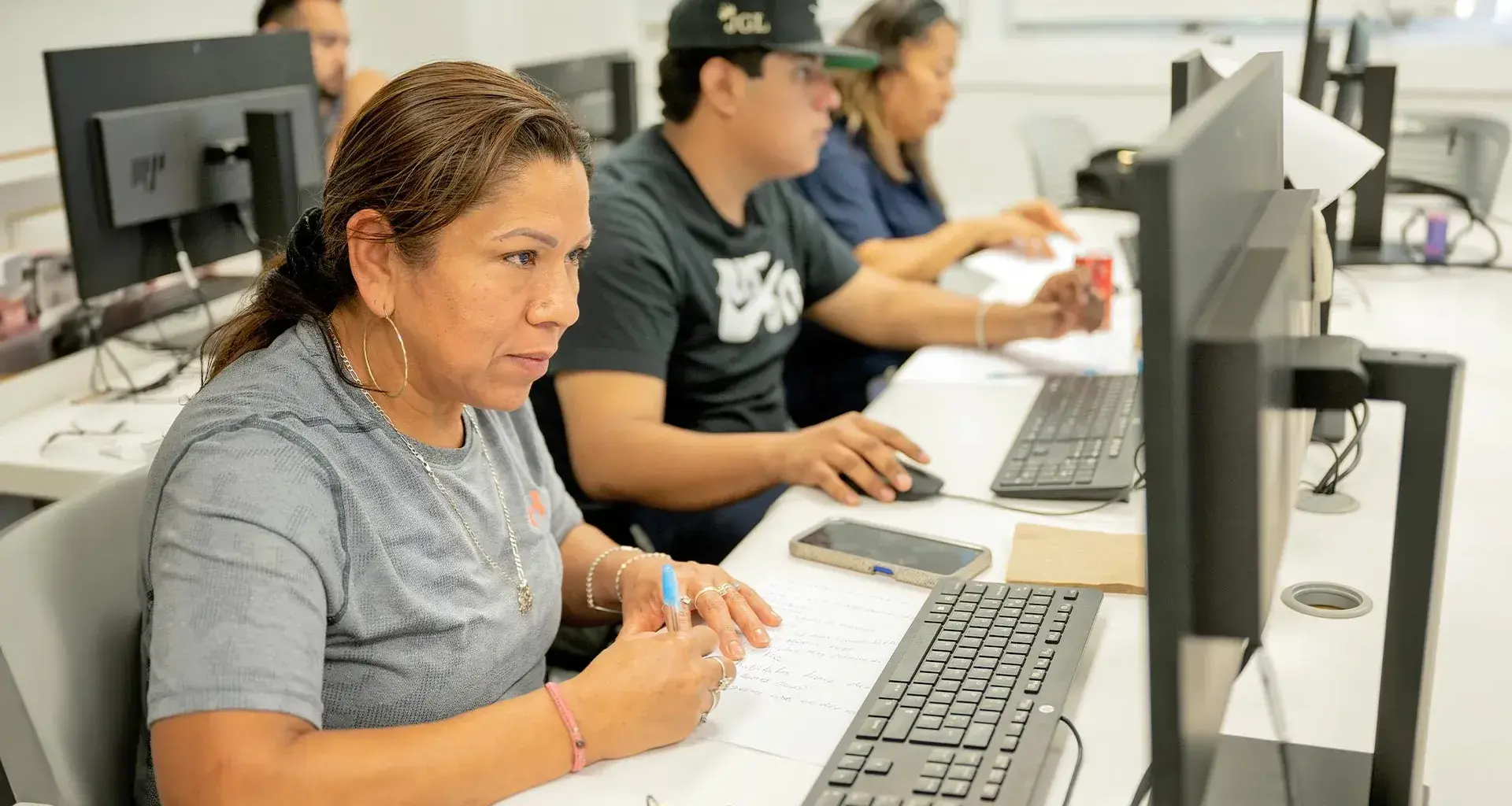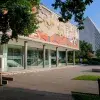Miss Vicky’s house sits in the highest part of Cerro de la Campana, where most services do not reach. Computershave now been installed there, and Internet access was provided for the first time to children and neighbors in the area.
This is one of the efforts being carried out within the Campana-Altamira area of Monterrey, Nuevo León, and is part of Tec de Monterrey’s Digital Inclusion initiative to close the gap currently existing throughout the country.
“Digital Inclusion arises as a solution to a problem: the digital divide, which is a disparity between those people who use technology and those who don’t,” said Carlos Bejos, national leader of Social Development at the Tec.
According to INEGI, 22% of the population in Mexico does not have access to the Internet; 63% do not use a computer; 66% do not have the skills to send an e-mail; and 67% do not use the Internet for educational activities.

The goal: to reduce the digital divide
This Tec leader pointed out that people who do not use or take advantage of technology face several disadvantages in their lives and are part of an exclusion group that is cut off digitally.
“The digital divide leads to fewer opportunities and lower quality of life such as difficulties to learn and study online and a lack of job opportunities, access to information, digital services, and online citizen participation,” he said.
He mentioned that there are three levels of the digital divide:
- Those who do not have access to equipment.
- Those who do have equipment but no access to the Internet.
- Those who have available equipment and Internet but do not know how to use them to their full potential.
He added that as technology and digitalization progress, the exclusion group is growing, so it is important to focus on this group and offer opportunities through digital inclusion to people who are part of it.
“Together with academia, companies, community organizations, and government, the Tec is seeking and guiding actions focused on promoting access to technology and digital literacy,” added Bejos.
“Digital Inclusion arises as a solution to the digital divide, which is a disparity between those people who use technology and those who don’t.”
The Tec’s Digital Inclusion Actions
Through the Digital Inclusion initiative, projects and actions are carried out in the community focused in general on five axes that promote:
- Access to technology.
- Digital literacy.
- Development of technological skills.
- Education and job training.
- Awareness of the problem.
“Digital Inclusion is a set of many social programs. Even PrepaNet is now part of this initiative. As of 2023, 269,000 people have been impacted, helping them to bridge their digital divide,” said Bejos.
To date, the initiative has an ecosystem that includes at least 27 programs in which several Tec teams are working together to bridge the digital divide.
It also has strategic allies, such as the Supérate platform developed jointly with the BBVA Foundation for diagnosis and digital remedial tutoring of middle and high school students.
The institution also promotes spaces such as the Virtual Learning Center, which takes advantage of new educational technologies to promote training and lifelong learning, looking to create better job opportunities.

Some of the projects that are part of Tec de Monterrey’s Digital Inclusion initiative today are:
Digital Labs
These are spaces equipped with technology, focused on serving people who are currently excluded from the digital world, to provide them with access, digital literacy, development of technological skills, education, and other services.
“It’s a space with components such as infrastructure, Internet connection, content, and educational resources such as courses, articles, and videos,” Bejos said.
These are labs that involve valuable partners, he said, such as schools, community leaders, and volunteers.
The spaces are organized in different formats and focus on adjusting to the needs of the society in which the aim is to reduce the digital divide. These include:
- Microlabs
These can be installed in homes and set up with one or two computers with Internet access to receive neighbors in the community.
“We’re looking for positive leaders who’ll receive computers from us and commit to opening the doors of their homesso that their neighbors can use the equipment to do homework, have meetings, or do online paperwork, for example,” he added.
“We’ll be happy when we see people get a personal benefit by closing their digital divide.”
One of the first microlabs is located in Cerro de la Campana, where equipment was installed to receive a wireless Internet signal from the CEDES building on the Tec’s Monterrey campus.
“With support from Victor González, the Tec’s community liaison in the Campana-Altamira initiative, we found Vicky, who welcomes children and helps them with tutoring. It was a natural fit because this woman and her family were already opening the doors of their home to the community.”
By working together with the Tec’s Vice-Presidency for Digital Transformation, they were able to share a surplus of broadband from the Monterrey campus with this community.
Commercial partners also joined the Tec to carry out this program, which will be implemented first in three communitiesin Monterrey, the State of Mexico, and Santa Fe.

- Solar Community Hub
This type of Digital Lab consists of centers powered by solar energy, equipped with technology, and connected to the Internet.
It is a Computer Aid and Dell Technologies initiative going back 10 years that the Tec is joining through an alliance to integrate disadvantaged communities in Mexico.
“They’re giving us the hub so that we can make an impact on the community. For this project, we also have the support of UKG and with that, it will be installed in Campo Los Pinos (in front of La Campana), and we’ll operate it on the Monterrey campus,” he said.
These centers are built in two refurbished shipping containers transformed into classrooms that take advantage of solar energy, energy-efficient technologies, and air-cooled servers.
Each hub has workstations to serve up to 40 people and offer wireless connection and Tec learning content for its users.
In addition, telemedicine and health services could be provided through a collaboration with TecSalud, along with job training and financial and legal advice.
The hub is expected to impact 5,000 people per year.
Currently, Dell and Computer Aid have installed three hubs of this type in the country: one in Xalapa, Veracruz; two in the State of Mexico; and a fourth, in La Campana (Monterrey), will be opened between April and May of this year.
“For the three hubs that are already open, the Tec is promoting our offering of digital literacy content to develop these skills,” explained the interviewee.

- Community Centers
These are public spaces operated by the government or civil organizations that already exist and offer services to the public.
“It’s an opportunity for us to be able to reach out and propose doing something together.
“Many community centers have equipped classrooms, and we have content. We’ve been training people to offer Tec content in these centers,” said Carlos Bejos.
The Tec offers courses through the Virtual Learning Center to train specialists, workshop leaders, and those in charge of 41 of Nuevo León’s Department of Equality and Inclusion’s community centers.
Similarly, they’re collaborating with the Barrio Esperanza civil organization in Cerro de la Campana to provide computers and content for the inhabitants of that sector.
“(At the Tec) we’re seeking and guiding actions focused on promoting access to technology and digital literacy.”
- Public Schools
School facilities are used to train teachers on technology and applications to improve their educational practice.
In addition, students can develop technological skills to improve their academic performance.
One example of this format was carried out at the Arturo B. de la Garza School in the Laderas del Mirador neighborhood in Monterrey, where the initiative made it possible to set up a laboratory with computer equipment.
“This space was cleaned, painted, furnished, and equipped with new wiring and computers for the school to use,” the national leader said.
Bejos celebrated the fact that the refurbishment of the space also involved volunteer actions organized by the Monterrey campus’s Physical Plant department.

- Computer Truck
These are vehicles adapted as classrooms and equipped with computers connected to the Internet to allow them to bring access, knowledge, and services to rural, unserved, or marginalized communities.
“It’s like a food truck, but with computers. We want to equip trucks with a computer room so that we don’t wait for the community to come to us, but rather we go to the community,” he added.
The classroom would be in the loading area of the truck with the necessary equipment and furniture to enable workstations to serve up to 10 people at a time inside the truck and provide service to more users simultaneously outside.
The project currently has a completed vehicle design and is working together with academics to define the operating model, the program, the communities to be involved, and the participation of students and volunteers.
It is estimated that each of these Computer Trucks could benefit about 4,000 people per year of operation.
“The dream we have is that, in a first stage, at least each region or each main campus can have one truck, and from there it can move to the communities,” said Bejos.
“It’s like a food truck, but with computers. We want to equip trucks with a computer room and go into the community.”
Zero digital divide among Tec employees
In addition to the Digital Labs, the Tec also promotes digital literacy and the development of technological skills among its employees, with the support of volunteer instructors through the Zero Digital Divide program.
A pilot version of this program was carried out over 16 sessions at the Monterrey, Laguna, and PrepaTec Eugenio Garza Sada campuses.
After this first phase, the second part of this initiative will be implemented starting in January of this year, taking the program to eight Tec campuses. Eventually, it will be implemented at all the institution’s campuses.
The national leader said that after deploying the program throughout the institution, the objective is to transfer it to all the Digital Laboratories for broad coverage throughout the community.
The goal: to transform lives and communities
The purpose of the Digital Inclusion initiative is not only to bring technology closer to people, said Carlos Bejos, but also to improve their quality of life with better opportunities.
“We’ll be happy when we see people get a personal benefit by closing their digital divide.
“For example, they can access better jobs or have better family conditions with educational opportunities,” he added.
For the leader of the initiative, the institution’s efforts to close the digital divide have a greater purpose: to transform communities and, through this, to have a social impact.
ALSO READ:





